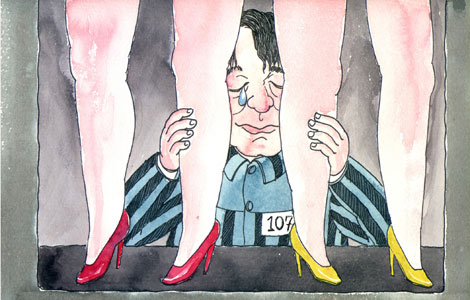China frees bank lending rates on reform agenda
Updated: 2013-07-19 20:10
(Xinhua)
|
|||||||||||
Private and small business play a critical role of stabilizing China's economy and social stability, as they turn out 90 percent of GDP and 80 percent of jobs. Marginalizing them harms growth momentum.
Henry Cai, executive chairman of corporate finance of Deutsche Bank's Asia Pacific region, said the marketization of interest rates will benefit the real economy, with needy enterprises getting cheaper loans and banks being refrained from earning monopolistic profits.
"It is the real economy, other than banks, that is short of money," he said.
The Chinese government is determined to regenerate its outdated economic system, with marketization of interest rates high on the reform agenda.
Last June and July, the central bank widened the floating bands for lending and deposit rates.
In the second quarter of 2013, the Chinese economy grew 7.5 percent year on year, down from 7.7 percent in the first quarter, as the government deliberately cooled down the growth in exchange for space for rebalancing the economy to allow for more sustainable expansion.
"From the macro perspective, the economy runs steadily and consumer prices remain stable, which means it's good timing for reform," according to the PBOC statement.
Cautions remain
Scrapping the controls is an important step toward interest rate marketization. However, it is insufficient, as the ceiling limit for deposit interest rates remains unchanged, said Zuo Xiaolei, chief economist at China Galaxy Securities.
The central bank keeps the 110 percent ceiling of guideline rates for deposits which have long been complained for eating up household saving values and refraining China from developing into a consumption-fueled economy.
"Keeping the ceiling for deposit rates is in consideration of lending rates' more profound impact [on the economy] which needs more mature conditions," the central bank statement said.
Globally, liberalizing the lending rates is the most critical and risky part of interest rate market reform. It will be carried out gradually and orderly, the statement said.
In June, the PBOC said the long-awaited deposit insurance system is ready to be launched. The system will help "increase the flexibility of commercial banks in terms of financial business innovation and risk control, and is believed as an essential tool to cushion the shock of reform to the banking system.
Deposit insurance programs protect bank depositors by guaranteeing that a certain level of deposits can be paid, even if a commercial bank goes bankrupt and cannot pay them.
"The central bank will work with other departments to improve the fundamental conditions to liberalize deposit rates steadily and orderly," according to the statement.
Related Stories
Fitch warns on wealth management product payouts 2013-06-22 02:53
Liquidity crunch to plague China? 2013-06-20 09:38
China vows to further liberalize interest rates 2013-05-25 10:01
PBOC faces balancing act with rate, inflation 2013-05-14 01:41
China ready to free capital flows? 2013-05-13 10:48
Reform set to broaden yuan range 2013-04-17 09:19
Today's Top News
Qinghai monks preaching the dangers of TB
Family of dead baby waits for autopsy
China pushes environment forward
Asiana legal fallout begins after deadly crash
Tokyo's 'big leap' aimed at China
Huawei backs UK security review
Maersk makes waves with container vessels
Floor on lending rates axed by PBOC
Hot Topics
Lunar probe , China growth forecasts, Emission rules get tougher, China seen through 'colored lens', International board,
Editor's Picks

|

|

|

|

|

|





